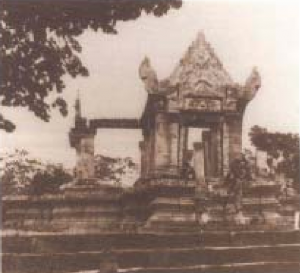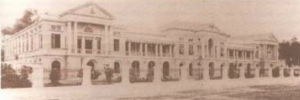One stone castle carving in Khmer art style in Preah Vihear Temple adjacent to Sisaket, Thailand’s border province, is considered as a piece of evidence indicating the occupation of the Khmer Empire in the lower Mekong River.
It has generally been recognised that most of Thai people who emigrated from the South of China would firstly settle down in the Mekong and Chao Phraya river basin, in the middle of Mon to the west and Khmer to the east. It’s problematical to figure out how the government in ancient time had been since there are only few books and none of them are written in Thai. It could be assumed that they initially domiciled around “12 Ju Thai” before expanding down south to “Kwaeng 12 Panna”, Lan Chang, Chiang Rai, Chiang Mai. Some of them set off further to Sukothai, Lopburi and U-Thong. Thai state gradually became independence of the weakened Mon and Khmer Empires that had occupied the north and the south respectively. The number of Thai immigrants and newborns had increased enough to build up their own cities. Chiang Rai, Chiang Mai, and Sukothai were later set up as capital cities independently before completely suppressing the Khmer and expanding the territory down to Lopburi. Thai state, which was independently located in Sukothai, spread its vast territory and has finally become the owner of Thailand since then. Therefore, Sukothai was the first capital city of Thailand in 1907. Regardless of the evidence for the principle of government, the character of Thai people could be determined from the inscription stone of King Ram Khamhaeng the Great and some books that Thai people loved freedom. Even they later severely suffered from competing among themselves and the invasion by other powerful nations. There is sufficient evidence proved that they deadly struggled for national independence as well.
Foretime, there were two different political features in Thailand. The first one is the doctrine of Lao people which considered the king as a father of citizen, “Por Krua (Father of the House)”, a person who rules every household in the village. “Por Krua” was subordinate to “Por Muaeng (Father of the state)”. In case of tributary states, their governors are called “Khun”. They governed the same way as a father looks after his children. The second one is the doctrine of traditional Khmer which is similar to Indian belief. The king is determined as Bodhisattvas or God Shiva. Thai state improved its political feature by coordinating these two doctrines based upon national interest. Chinese and other foreigners had also been united as Thai people until now.
From the ancient times to the age of Ayutthaya, Thai state was actually still stuck in the period of usurpation and often had to go to wars with Khmer, Mon, and Burma. In fact, the king as the head of state would have dealt and modified some policies as appropriate according to the change of world situation at that time. Despite of rare publication, there are a few evidences indicating that the ancient civilian government was divided into four departments; Wiang (the Department of Local Government), Wang (the Department of Royal Household), Klang (the Department of Treasury), and Na (the Department of Agriculture). These four departments were known collectively as “The Four Columns” or “Jatusadom”. The idea of Jatusadom could be seen in India, Burma, Khmer, Java, or Malay. Jatusadom in Thailand tended to be influenced by Khmer. Likewise the principle of military, the chief of Jaturongkasena (the four arms of an ancient army) controlled each sector of civil administration.
Senabodi Krom Mueang or Minister of Interior was a local administrative officer responsible for maintaining peace, internal security, and citizenship in his area.
Senabodi Krom Wang or Minister of the Royal Household was the chief of royal court, also performed as the Minister of Justice, called “Thammathikorn” since the ancient tradition believed that the king was the one who provided fairness and formulated human behaviour. When people had conflicts, they brought to the king who would judge and forced the offenders to take the punishment. Basically, the King of the Kingdom had to rule a large royal territory and it was exactly impossible to do. Even so, some of them, like King Ram Khamhaeng the Great, preferred to do so. Therefore, everybody could bring their problems to the king directly, as there was a bell in front of the palace for this purpose. This system only benefited to people in and around Sukothai. For this reason, the king had decentralised his power to Senabodi Krom Wang (Ministry of Justice officials) to procure for judicial service in various provinces and reported to the king.
Saranrom Palace, the office of Ministry of Foreign Affairs since the reign of King Rama V until today
Senabodi Krom Phra Klang or Minister of Finance was responsible for the state’s finance, taxation and adjudication in matters of royal properties. There were four kinds of tax in Ayutthaya period namely,
Trade was the beginning of the relation between Krom Phra Klang and foreign affairs. In in the middle period of Ayutthaya, Krom Phra Klang was accountable for trading with foreigners. Such contact gradually extended to almost all other activities concerning foreigners, including reception of and negotiation with foreign envoys. The conduct of foreign affairs was then entrusted to Krom Phra Khlang by setting up a new sub-department namely “Krom Tha, to deal primarily with all port activities. Treasury and foreign affairs continued under the same chef administrator (Senabodi) until Rattanakosin period. Krom Phra Klang and Krom Tha were separated in the late reign of King Rama IV and set up independently as Ministry of Foreign Affairs and Ministry of Treasury in the early reign of King Rama V.
In 1875, Phra Klang was set up as a ministry at Ratsadakorn-bhibhatthana Hall which was the first ministry that organised in a western way. To be exact, officials worked in office hours every day and received payment in form of salary instead of the fee. The king thought that Prince Mahamala Krom Phra Bamrab Porapak served as the director-general of Minister of the Royal Household and Krom Phra Klang. His majesty then allowed him to continue working at the palace until 1885, Prince Devawongse Varoprakar (Krom Muen) was Senabodi Krom Tha (Chief of Treasury Department) suggested that there should be a workplace so he asked permission from the king to use Saranrom palace as an office of the Ministry of Foreign Affairs. Prince Devawongse Varoprakar was the first senabodi who worked in office hours every day and received salary as same as other officials in the ministry.
Senabodi Krom Na or Minister of Agriculture formerly worked as a farming inspector and entitled the land for farming. His tasks were considered to be extremely vital by farming as a career of majority of people in this country. Furthermore, the duty of collecting lean paddy rice to royal barn was crucial to food supply for the battalions to protect the country. For those who inconvenient to transport paddy rice could pay money instead that was subsequently called “farm tax”.
The division of the four ministers had established since Ayutthaya period or earlier. The annals revealed that these mechanisms had implemented until the reigns of King Borommatrailokkanat and his son around 1463. The ministry of Defence (military) and Interior (civil) are greater sizes than Wiang, Wang, Klang, and Na as the chief of defence and interior were the royal commissioners who had high authority. Hence, there were six departments throughout Ayutthaya, Thonburi and Rattanakosin. King Rama V decided to modify the scope of authority and duties as well as to modernise some tasks but the principle remained unchanged.


